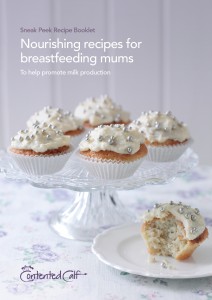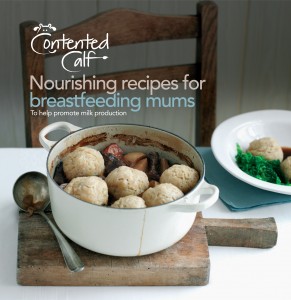After breastfeeding seven children, I know how important eating the right foods is, to keep mum healthy and strong enough to feed baby, so when I was asked if I would like a guest post from Elena, I was delighted.
Elena Cimelli of Contented Calf runs through the basics of how a lactogenic rich diet can contribute toward aiding milk supply during nursing…
Breastfeeding can be demanding on energy levels; on average a mother will burn between 300-500 calories a day to produce milk. Eating sufficient calories and getting an abundant supply of nutrients is in itself helpful for lactation. A lactogenic diet, along with a correct latch and frequent feeding, are all ways to facilitate a successful breastfeeding experience.
Here at Contented Calf, we are dedicated to supporting the chemistry of lactation through the aid of lactogenic foods which we’ve incorporated into our recipes to ensure the correct nutritional balance to satisfy both mother and baby’s needs.
A successful breastfeeding experience is governed by a number of contributing factors, as highlighted in this Milk Supply Equation¹:
1. Sufficient glandular tissue
+ 2. Intact nerve pathways AND ducts
+ 3. Adequate hormones AND hormone receptors
+ 4. Adequately frequent, effective milk removal and stimulation
= GOOD MILK PRODUCTION
A lactogenic diet plays a role in the third point: hormones. The process of making breast milk (lactogenesis) is heavily dependent on two hormones – Prolactin and Oxytocin. Anything that helps the body increase the levels of both in our bloodstreams can help increase milk supply, and improve flow.
What are Lactogenic foods?
Lactogenic or Galactagogues are terms applied to food and herbs that help stimulate lactation, by helping to increase the levels of prolactin in the bloodstream. Lactogenic foods contain substances thsat interact with and support the chemistry of lactation. Lactogenic agents inclue tryptophan, natural plant sedatives, polysaccharides, fatty acids, saponins and plant sterols, among others.
Prolactin
Prolactin is the hormone that’s responsible for stimulating the mammary glands to produce milk (lactation). Lactogenic substances such as Tryptophan, sedative vegetables and polysaccharides all promote the production of Prolactin, and can be found in the following foods:
Tryptophan:
Fruit: apricot
Grains: oats, barley, wheat
Herbs & spices: basil, chives, black pepper, fennel, garlic
Leafy greens: watercress, spinach
Legumes: beans, chickpea, peas
Meat & fish: Calf liver, halibut, lamb, salmon, tuna, venison, poultry
Natural sugars: honey, malt syrup, maple syrup
Nuts: almond, cashews
Seeds: evening primrose, pumpkin, sesame, sunflower, fenugreek
Vegetables: asparagus, carrot, cauliflower, celery, fennel, jerusalem artichoke, lettuce, onion, potato, sweet potato.
Sedative vegetables: fennel, lettuce, onion, potato.
Polysaccharides: barley, oats, yeast.
Some of my favourite recipes containing foods that promote prolactin include: Sweet Potato & Pecan Muffins, Thai Coconut & Chicken Soup and Apricot & Cardamom Crumble (in the words of one of my friend’s husband: the best crumble he’s EVER had!)
Oxytocin
Oxytocin helps support the milk flow or the ‘let down’. If the production of Oxytocin is in anyway suppressed, the ‘let down’ is inhibited (regardless of how successful actual milk production has been). The result of a poor level of Oxytocin can mean that the breasts aren’t fully emptied and so, milk supply gradually dwindles.
Stress hormones can contribute to suppressing the production of Oxytocin, so it very important to eat meals and snacks throughout the day, as hunger can induce stress. We recommend, Hilary Jacobson’s Mother Food, which provides a list of food remedies for problems with let-down, originally recommended by the 1st Century AD Greek Doctor Dioscorides. This list comprises the following foods and herbs: anise, basil, dill, fennel (garden and wild), lettuce.
Some of our favourite recipes in The Contented Calf Cookbook containing these ingredients include: Vanilla & Star Anise Poached Plums, Grilled Prawns with Fennel Slaw and Oven-baked Beetroot Risotto.

About Contented Calf
The Contented Calf Cookbook: Nourishing Recipes for Breastfeeding Mums is a unique book of delicious meals especially devised to help breastfeeding mums boost their milk supply. It provides an easy way of introducing lactogenic ingredients into the postpartum diet, but over half of the main meals are designed to be made in the final weeks and months of pregnancy and frozen, so new parents will have a freezer full of tasty, nourishing ‘ready meals’ for the first few weeks of parenthood.

First published in 2011, it’s the inspiration of mother of two, Elena Cimelli and food writer Jassy Davis. Drawing upon her experiences of parenthood and breastfeeding with her first born, Elena was led to consider the importance of lactogenic ingredients. Armed with first-hand experience of just how time consuming a new baby can be, the aim was to provide new mums with quick, simple, tasty and nutritious meal options that would help support nursing mums milk supply.
The cookbook (£14.99), a NEW ‘Sneak Peek’ recipe booklet (£2.99) and NEW e-book (£7.99) are all available to purchase from The Contented Calf website which is also packed with useful information and resources for nursing mothers. Visit: www.contentedcalf.com
References:
¹The Milk Supply Equation is from the book A Breastfeeding Mother’s Guide to Making More Milk by Diana West and Lisa Marasco



